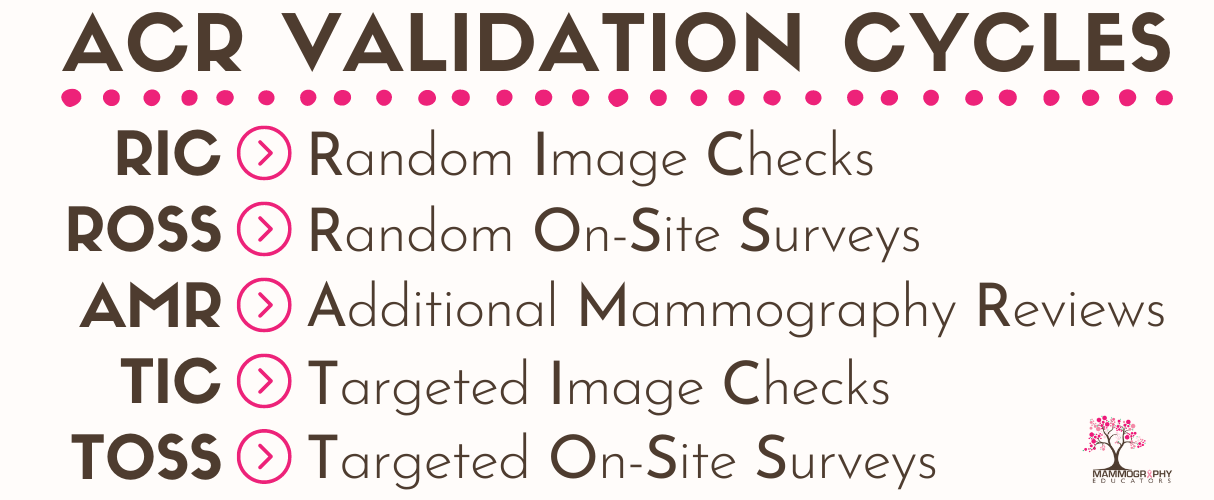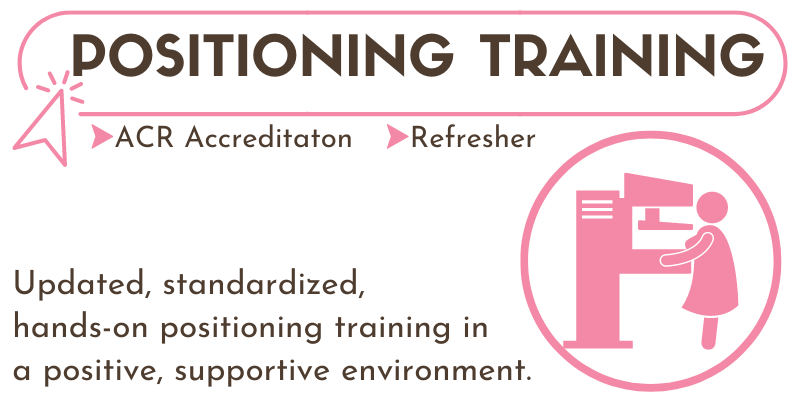Getting a notification from ACR that your facility will be undergoing an additional evaluation/validation review strikes fear in the hearts of most members of the breast imaging team. Technologists, radiologists and the administrative team all "quiver in our boots". (Whatever that means!) It is important however, to try to remain calm (yeah, right!), but also be prepared for how your image quality will be evaluated.
"These Validation Cycles, which were revised and published by the ACR in February 2023, are testing cycles which do not grant accreditation. These cycles are to validate that your facility is consistently operating within MQSA and ACR requirements and guidelines. Some validation cycles are random, and some cycles are performed for a particular concern regarding image quality." (1)
It is important to remember that these validations, in addition to ACR accreditation processes, are required by the MQSA to ensure that every facility is producing high quality images, which was the initial goal of the law. It is also important to remember that poor image quality (particularly related to positioning) reduces the sensitivity of mammography (the ability to find cancers) by 18%. (2) So, while these processes may feel punitive, they really are in the best interest of our patients and may in fact provide an opportunity to identify areas of improvement and mandate training that may not otherwise be prioritized.
There are many acronyms related to the checks, reviews and surveys. (I know, who knew?!) While details regarding each process are clearly spelled out and explained on ACR's website, I thought it might be helpful to provide a brief description of each.

RIC (Random Image Check)
First of all, keep in mind that facilities are randomly chosen... you are not being targeted. The LIP, technologist contact and account login will all receive an email with specific instructions on how to submit images. Reviewers take into consideration that there are differences in patient volumes and take account for anatomical differences and challenges. You will then receive a report upon completion. If you pass, Great! However, if you receive a deficiency report, you must provide a corrective action plan (CAP) within 14 calendar days of the report, plus pay a fee. After ACR approves your CAP, you can then begin putting your plan into action, which may include on-site positioning training, courses for technologists and radiologists, etc. You must then provide documentation of the completion of your corrective action within 60 days of the deficiency report. Finally, your site is required to participate in another RIC (or undergo early accreditation renewal if there is less than 13 months left on your accreditation) to show that you have adequately addressed and corrected the problems that were identified in the report.
ROSS (Random On-site Survey)
MQSA/FDA requires the ACR to conduct on-site surveys, which you will be notified of in advance. Members of the survey team include an ACR radiologist, medical physicist reviewers and an ACR staff technologist. They will review the facility’s QA and QC programs, mammography policies and procedures, personnel qualifications, clinical images and mammography reports, as well as acquire and evaluate a phantom image. Again, rather than viewing this process as punitive, instead view it as an opportunity to learn and interact with experts in the field of mammography, and provide them with the necessary information needed to validate your accreditation.
AMR (Additional Mammography Reviews)
TIC (Targeted Image Checks)
TOSS (Targeted On-Site Surveys)
If the FDA, ACR or other certifying agency (i.e., individual states) believe that a facility is producing a level of mammographic quality that “has been compromised and may present a serious risk to human health” (3), you may be required to submit between 2 and 30 clinical image cases and other relevant information for review and a fee will be charged to the facility. These processes are used as a follow-up to previous image quality concerns, may include the submission of a phantom image and may be reviewed as part of an on-site survey at a facility or through submitting images to ACR. It may also be required if facilities receive repeat EQUIP violations. (4) The facility will be notified by the ACR of the need for an AMR and request images from specified dates. After the review, a final report will be issued to the LIP and forwarded to the FDA or other certifying body.
Final Thoughts...
All of this may seem quite ominous (I mean, yikes!), remember that if you have been diligent in providing an environment that is conducive to constant quality improvement for all breast imaging team members, there should not be a problem! It is also important to note that even some of the best breast imaging departments have had their ”dings” and failures during any and all parts of inspection, accreditation process and surveys. While a swim in the Alphabet Soup may not be fun, you won’t drown! By embracing a proactive mindset paired with a clear plan to establish and maintain an environment of excellence through continuous education, learning, and growth, you'll be just fine.
REFERENCES:
- Katie Albus, "Validation Cycles: Mammography (Revised 02-22-2023)", https://accreditationsupport.acr.org/support/solutions/articles/11000051607-validation-cycles-mammography-revised-02-22-2023-
- Ekpo EU, Alakhras M, Brennan P. Errors in Mammography Cannot be Solved Through Technology Alone. Asian Pac J Cancer Prev. 2018 Feb 26;19(2):291-301. doi: 10.22034/APJCP.2018.19.2.291. PMID: 29479948; PMCID: PMC5980911.
- 900.12(j)(1)(2): Additional mammography review and patient notification.https://www.accessdata.fda.gov/cdrh_docs/presentations/pghs/Additional_Mammography_Review_Patient_Notification.htm
- Mammography Quality Standards Act (MQSA)Enhancing Quality Using the Inspection Program (EQUIP)Frequently Asked Questions - Facilities. U.S. Food & Drug Administration. https://www.fda.gov/media/101293/download



